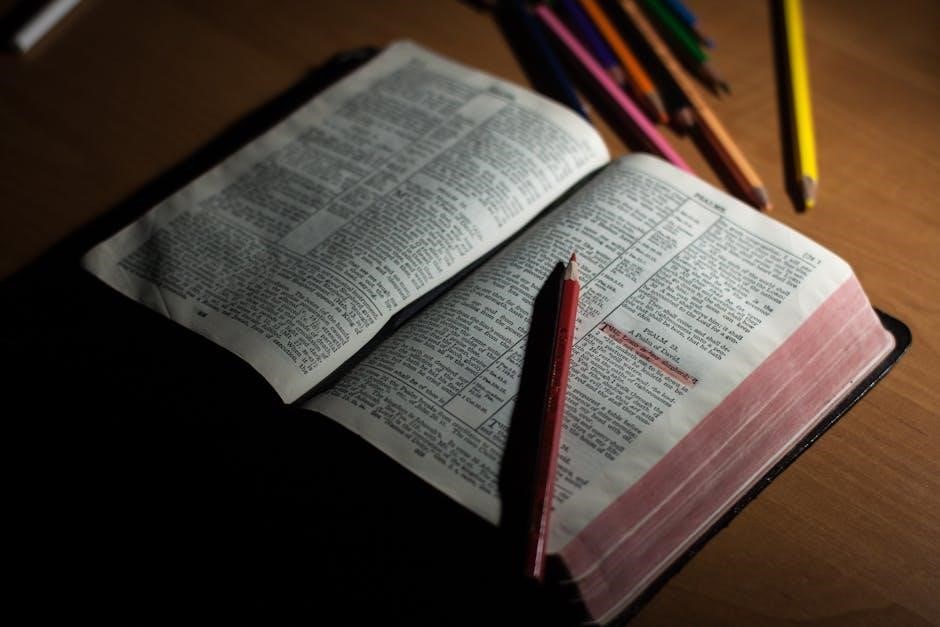
freemasonry bible pdf
Freemasonry and the Bible share a deep historical and symbolic connection, with the Bible often serving as a foundational text in Masonic rituals and teachings;
1.1 Overview of Freemasonry
Freemasonry is a fraternal organization with roots in medieval stonemasonry, evolving into a society focused on moral and spiritual growth. It emphasizes brotherly love, relief, and truth, using rituals and symbols to convey ethical lessons. Members, known as Masons, progress through degrees, each teaching profound moral and philosophical truths. The organization is not a religion but encourages members to uphold their faith. Freemasonry fosters self-improvement, camaraderie, and community service, making it a unique blend of tradition and modern values.
1.2 The Role of the Bible in Freemasonry
The Bible plays a central role in Freemasonry, often referred to as the “Great Light” in Masonic rituals. It is placed alongside other sacred texts, symbolizing truth and moral guidance. Freemasonry does not impose religious beliefs but encourages members to reflect on biblical teachings for ethical living. The Bible’s stories and symbolism are integral to Masonic education, inspiring personal growth and brotherly unity. Its presence underscores Freemasonry’s commitment to universal moral values, making it a unifying force across diverse cultural and religious backgrounds.
1.3 Purpose of the Article
This article serves as an introductory guide to understanding the connection between Freemasonry and the Bible, exploring their historical ties, symbolic meanings, and the Bible’s role in Masonic rituals. It aims to provide clarity on how Freemasonry integrates biblical teachings into its principles and practices. The article is designed for those interested in Freemasonry, offering insights into its core values and the significance of the Bible within the Masonic tradition. By examining these elements, readers will gain a deeper understanding of the interplay between Freemasonry and the Bible.

Historical Context of Freemasonry
Freemasonry’s historical roots trace back to medieval stonemasonry guilds, evolving into a fraternal organization blending moral teachings with spiritual symbolism, deeply influenced by biblical narratives and principles.
2.1 Origins of Freemasonry
Freemasonry traces its origins to medieval stonemasonry guilds, where skilled craftsmen built cathedrals and adhered to moral codes. Over time, these guilds evolved into fraternal organizations, blending practical craftsmanship with philosophical and spiritual ideals. The transition from operative to speculative Masonry in the 17th and 18th centuries marked a shift toward a more symbolic and ethical focus. Early Masonic texts, such as the Regius Manuscript and Cooke Manuscript, reveal influences from biblical teachings, folklore, and chivalric traditions, laying the groundwork for modern Freemasonry’s blend of faith, morality, and brotherhood.
2.2 The Bible as a Founding Document
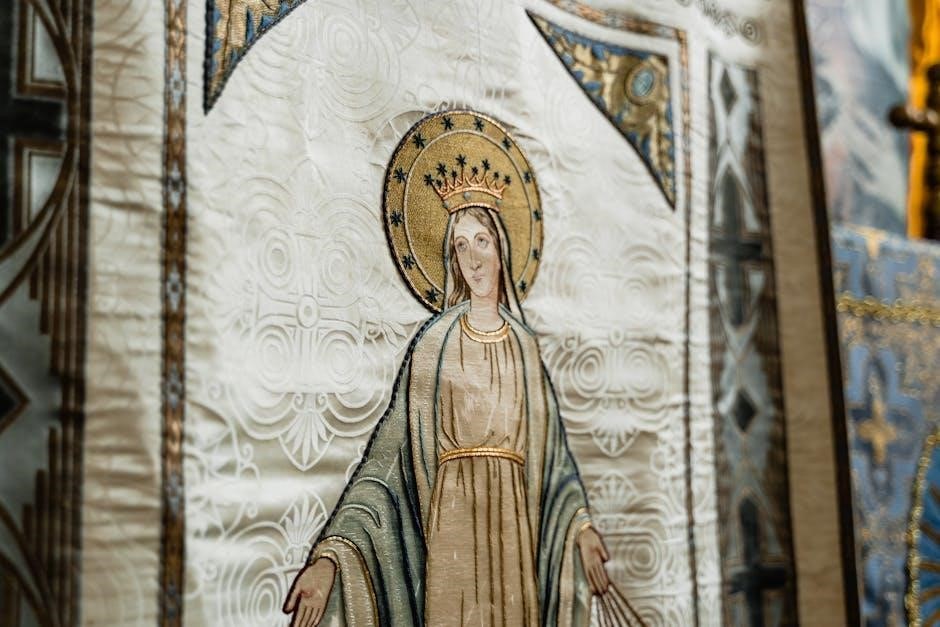
The Bible is central to Freemasonry, serving as a foundational text and moral guide. Its teachings are woven into Masonic rituals, with biblical stories and symbols used to convey ethical lessons. The Bible’s emphasis on justice, compassion, and truth aligns with Masonic principles. Historical texts, such as the Regius Manuscript and Cooke Manuscript, highlight the Bible’s role in shaping early Masonic philosophy. This sacred text remains a unifying force, bridging cultural and temporal divides, and reinforcing Freemasonry’s commitment to moral development and spiritual growth.
2.3 Evolution of Masonic Teachings
Over centuries, Masonic teachings have evolved, blending medieval stonemasonry traditions with Enlightenment-era philosophical ideas. Early Masonic texts emphasized biblical morality and symbolism, while later developments incorporated broader ethical and universal principles. The Bible remained a cornerstone, but interpretations became more allegorical, reflecting changing societal values. This evolution allowed Freemasonry to adapt to cultural shifts, maintaining its relevance while preserving core values like brotherly love and moral integrity. The teachings continue to inspire personal growth and community service, ensuring Freemasonry’s enduring appeal.

Core Principles of Freemasonry
Freemasonry’s core principles emphasize brotherly love, moral values, and ethical conduct, grounded in biblical teachings. These tenets foster personal growth and societal improvement, aligning with the Bible’s wisdom.
3.1 Brotherly Love
Brotherly love is a central tenet of Freemasonry, emphasizing unity, compassion, and mutual respect among members. Rooted in biblical teachings, it reflects the command to “love thy neighbor as thyself” (Leviticus 19:18, John 13:34-35). This principle fosters a sense of fraternity, transcending social, cultural, and religious divides. Masons are encouraged to practice this virtue in their interactions, both within and outside the lodge. By promoting harmony and kindness, brotherly love serves as a cornerstone for personal and collective growth, aligning with the moral lessons found in the Bible.
3.2 Moral Values and Ethics
Moral values and ethics are cornerstone principles of Freemasonry, deeply intertwined with biblical teachings. Freemasonry emphasizes truth, justice, and integrity, urging members to lead virtuous lives. The Bible serves as a moral compass, guiding Masons to uphold ethical standards in their personal and communal lives. These values are reinforced through rituals and teachings, encouraging self-reflection, honesty, and compassion. By fostering a strong moral foundation, Freemasonry aligns with the biblical ethos of righteousness and responsible living, promoting the betterment of individuals and society.
3.4 The Importance of the Bible in Masonic Rituals
The Bible holds a central place in Masonic rituals, often placed alongside other sacred texts. Its teachings are woven into ceremonies, emphasizing moral lessons and symbolic truths. Masonic rituals frequently reference biblical narratives, such as the construction of Solomon’s Temple, to illustrate ethical and spiritual principles. The Bible is presented as a source of divine truth, guiding members toward a virtuous life. Its presence underscores the fraternity’s commitment to moral development and unity, reinforcing the belief that spiritual growth is essential to personal and collective progress.
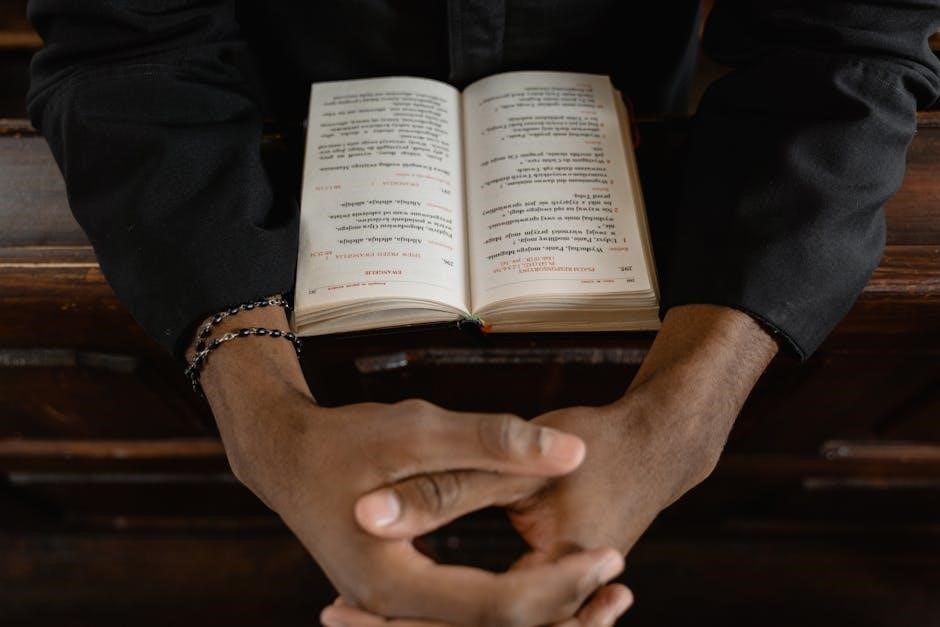
Symbolism in Freemasonry and the Bible
Freemasonry and the Bible share rich symbolic imagery, such as the All-Seeing Eye and the Square and Compasses, which convey moral and spiritual truths.
4.1 The All-Seeing Eye
The All-Seeing Eye is a prominent symbol in Freemasonry, often depicted as an eye within a triangle, symbolizing divine providence and omniscience. It is frequently associated with the Great Architect of the Universe, a central deity in Masonic teachings. This symbol is also rooted in biblical imagery, such as the “eye of the Lord” mentioned in Proverbs 15:3, which watches over the righteous. In Masonic rituals, the All-Seeing Eye reminds members of moral accountability and the idea that their actions are observed by a higher power. Its presence in lodges and literature underscores its significance in guiding Masonic principles and conduct.
4.2 The Square and Compasses
The Square and Compasses is the most recognizable symbol of Freemasonry, representing moral conduct and wisdom. The Square signifies honesty and integrity, while the Compasses embody boundaries and self-control. Together, they reflect the Masonic principles of living a virtuous life. Biblically, these tools parallel teachings like “do unto others as you would have them do unto you” (Matthew 7:12) and the wisdom of Proverbs. In Masonic rituals, they remind members to align their actions with moral truths, ensuring harmony between spiritual and earthly realms. Their prominence in Masonic philosophy highlights their enduring relevance.
4.3 Biblical Symbols in Masonic Art
Biblical symbols are integral to Masonic art, reinforcing moral and spiritual lessons. The All-Seeing Eye, symbolizing divine providence, is often depicted alongside the Bible. The Dove, representing peace, and the Lion of Judah, embodying strength, are prominent. These symbols, rooted in scripture, are used to illustrate Masonic principles such as faith, hope, and charity. Masonic art often blends these biblical motifs with architectural elements, creating a visual narrative that underscores the fraternity’s values. This artistic tradition serves as a reminder of the enduring connection between Freemasonry and biblical teachings.
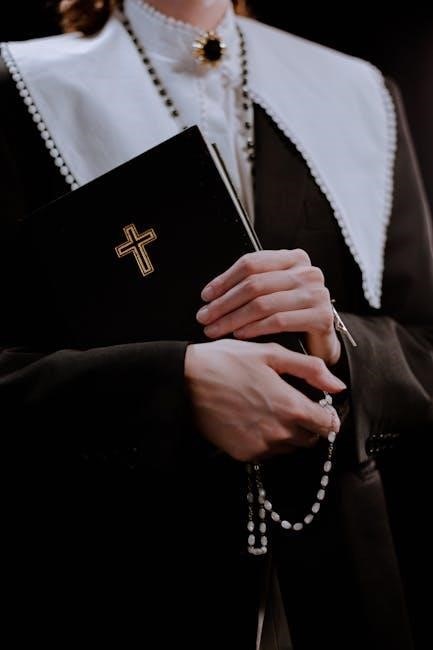
The Bible as a Masonic Text
The Bible holds a central place in Masonic rituals, serving as a source of moral and spiritual guidance. Its teachings are integrated into Masonic philosophy, emphasizing truth, justice, and compassion.
5.1 The Use of Scripture in Masonic Rituals
The Bible is a central text in Freemasonry, often used in rituals to emphasize moral and ethical principles. Scriptures are recited to guide members in their journey toward enlightenment and brotherhood. Masonic rituals frequently incorporate biblical passages, such as those from Psalms or Proverbs, to illustrate key teachings. The Bible is also used ceremoniously, such as in the swearing of oaths, symbolizing truth and fidelity. This integration of scripture reinforces the importance of living a virtuous life and fosters a sense of unity among members.
5.2 Key Biblical Stories in Freemasonry
Freemasonry draws heavily from biblical narratives, using them as allegorical teachings. The construction of King Solomon’s Temple and the story of Hiram Abiff are central, symbolizing the pursuit of wisdom and the dangers of corruption. The tale of Noah’s Ark represents divine mercy and salvation, while Jacob’s ladder signifies the ascent toward spiritual enlightenment. These stories are integral to Masonic rituals and moral instruction, emphasizing principles like brotherly love, relief, and truth.
5.3 Interpretation of Biblical Teachings
Freemasonry interprets biblical teachings through allegory and symbolism, emphasizing moral and ethical lessons. The Bible is viewed as a guide for personal growth and brotherly unity, rather than a literal historical text. Masonic teachings often highlight themes like justice, compassion, and self-improvement, drawing parallels between biblical narratives and universal truths. This interpretative approach encourages members to reflect on their actions and strive for moral excellence, aligning with the fraternity’s core values of brotherly love, relief, and truth.
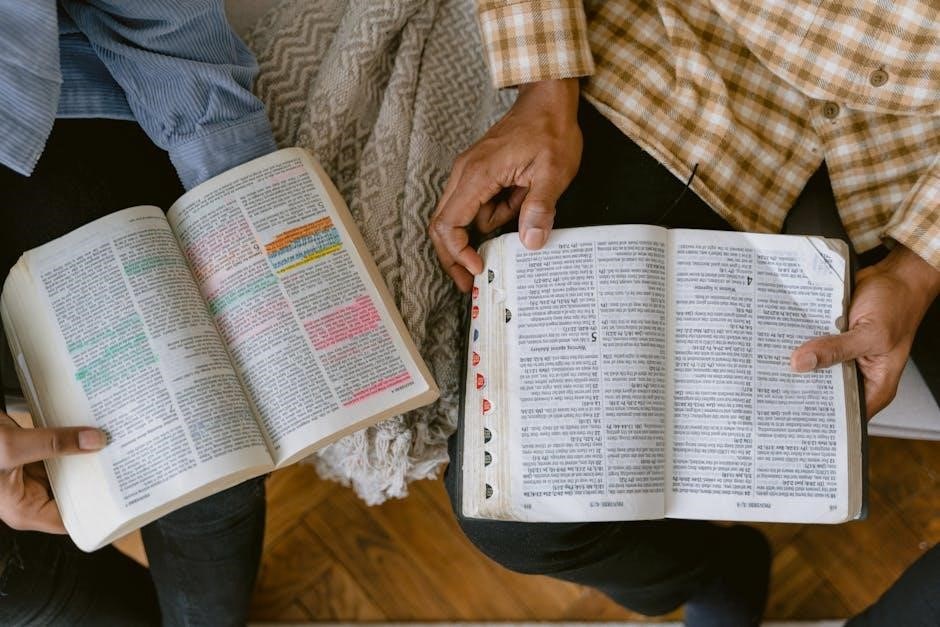
Freemasonry and Christianity
Freemasonry and Christianity share moral principles, but Freemasonry is not a religion. It encourages spiritual growth while respecting diverse beliefs, leading to some debates about compatibility.
6.1 The Relationship Between Freemasonry and the Church
Freemasonry’s relationship with the Church has historically been complex, with some religious leaders viewing it as incompatible due to its secretive nature and perceived heresy. The Catholic Church, for instance, has openly condemned Freemasonry, citing its alleged opposition to Christian doctrine. However, many Freemasons identify as Christians and argue that the fraternity complements, rather than conflicts with, their faith. This tension stems from differing interpretations of Freemasonry’s spiritual teachings and its emphasis on universal brotherhood over specific religious dogma.
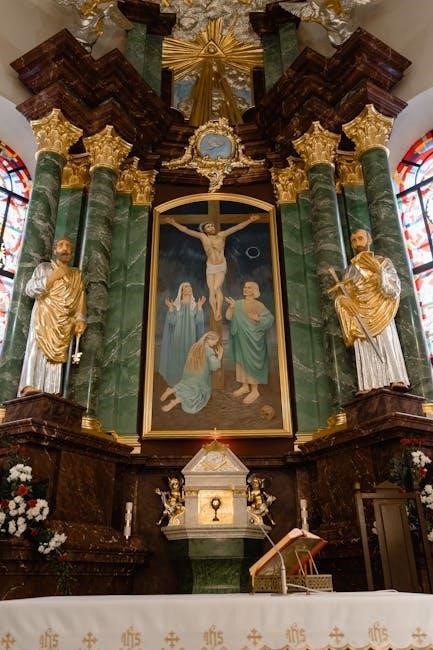
6.2 The Bible as a Unifying Force
The Bible serves as a unifying force within Freemasonry, bridging cultural and religious divides. As a shared moral guide, it fosters a sense of brotherhood and common purpose among members. Freemasonry embraces the Bible’s teachings on compassion, justice, and integrity, using them to promote unity and ethical living. By elevating the Bible as a central text, Freemasonry creates a shared framework for understanding and mutual respect, transcending denominational differences. This universal approach underscores Freemasonry’s commitment to harmony and the betterment of humanity.
6.3 Controversies and Misunderstandings
Freemasonry has faced criticism and misunderstandings, particularly from certain Christian groups, due to its interpretation of the Bible and its inclusion of members from various faiths. Some view Freemasonry as incompatible with Christianity, arguing that its rituals and symbols blur the line between religion and fraternity. Misconceptions about secret teachings and alleged contradictions with biblical doctrine have fueled controversy. However, Freemasonry emphasizes moral values and personal growth, seeing itself as a complement to, not a replacement for, religious faith. These debates highlight the complexities of Freemasonry’s relationship with the Bible and Christianity.
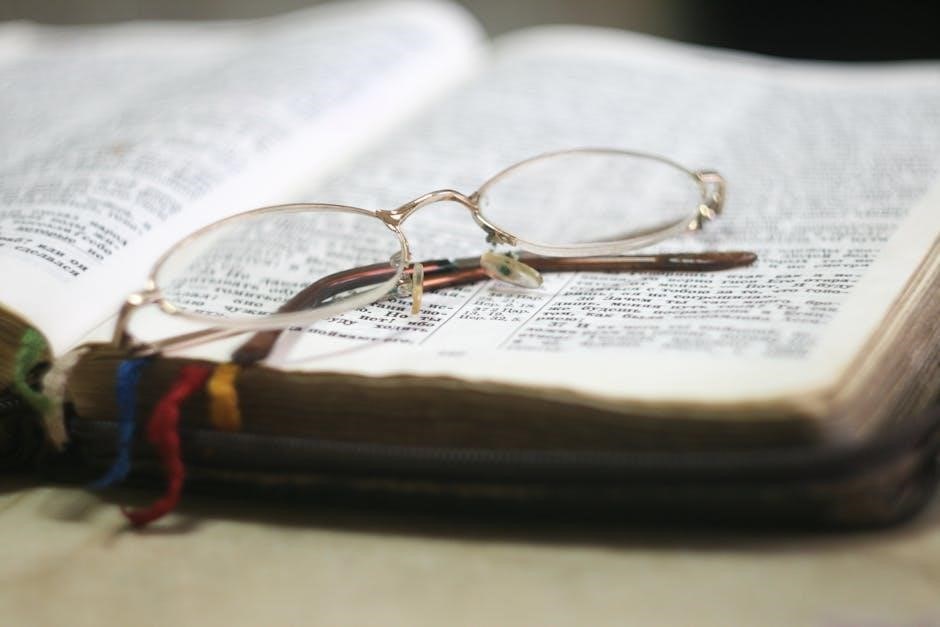
Modern Relevance of Freemasonry
Freemasonry remains relevant today by fostering brotherly love, moral integrity, and community service, offering a timeless framework for personal growth and unity in a diverse world.
7.1 Freemasonry in the 21st Century
Freemasonry in the 21st century continues to evolve, blending ancient traditions with modern values. The fraternity adapts to societal changes while preserving its core principles of brotherly love, moral values, and service. Technology has enabled global connectivity among Masons, fostering collaboration and sharing of ideas. The Bible remains central in rituals, symbolizing divine truth and moral guidance. Modern Freemasonry emphasizes inclusivity, welcoming individuals from diverse backgrounds. Community service and charity work remain vital, addressing contemporary challenges such as social inequality and disaster relief. This balance of tradition and innovation ensures Freemasonry’s relevance in today’s fast-changing world.
7.2 The Role of the Bible in Modern Masonic Practices
The Bible remains a cornerstone in modern Masonic practices, often displayed alongside other sacred texts to reflect the fraternity’s inclusive nature. It is frequently used in rituals to emphasize moral and ethical teachings, reinforcing principles of truth and justice. Many Masons draw inspiration from its wisdom, applying its lessons to contemporary life. While interpretations may vary, the Bible’s symbolic presence serves as a unifying force, reminding members of their shared commitment to brotherly love and personal growth. Its role adapts to modern contexts, ensuring relevance for today’s Masons.
7.3 The Appeal of Freemasonry Today
Freemasonry’s timeless principles of brotherly love, moral values, and self-improvement continue to attract individuals seeking purpose and connection in a rapidly changing world. Its blend of tradition and modern relevance appeals to those interested in personal growth, community service, and intellectual exploration. The fraternity offers a space for meaningful dialogue, fostering unity among diverse backgrounds. For many, Freemasonry provides a sense of belonging and a framework for navigating life’s challenges with integrity. Its enduring appeal lies in its ability to adapt while preserving its core values, making it a vibrant and inclusive organization in contemporary society.
Freemasonry and the Bible remain deeply intertwined, offering timeless wisdom, moral guidance, and a foundation for brotherhood, ensuring their enduring relevance and significance in modern times.
8.1 Summary of Key Points
Freemasonry and the Bible are deeply connected, with the Bible serving as a moral and symbolic foundation. Freemasonry emphasizes brotherly love, moral values, and ethical conduct, aligning with biblical teachings. The Bible is central to Masonic rituals and symbols, such as the All-Seeing Eye and the square and compasses, which carry profound spiritual significance. While controversies exist, Freemasonry continues to promote unity and personal growth, drawing inspiration from biblical principles to foster a better understanding of humanity’s shared values and spiritual journey.
8.2 The Enduring Legacy of Freemasonry and the Bible
Freemasonry and the Bible have left an indelible mark on history, culture, and spirituality. Their shared themes of morality, unity, and personal growth continue to resonate across generations. The Bible’s influence on Masonic rituals and symbols underscores its enduring relevance, while Freemasonry’s emphasis on brotherly love and ethical living reflects timeless biblical principles. Together, they embody a legacy of wisdom, fostering understanding and fellowship among diverse communities. This profound connection remains a cornerstone of Freemasonry’s identity and its contribution to human progress.
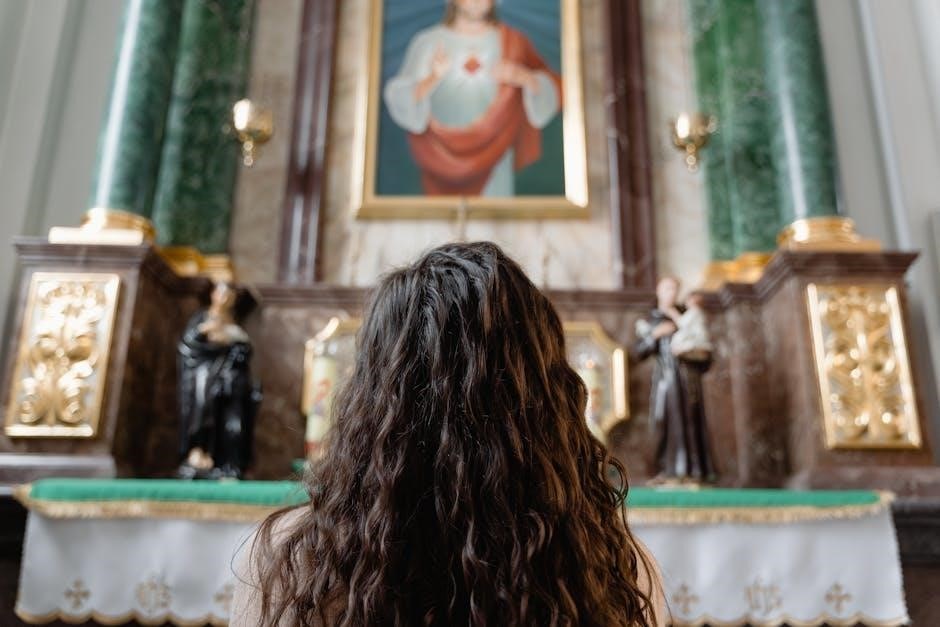
Additional Resources
Explore recommended books, online resources, and PDFs for deeper insights into Freemasonry and its connection to the Bible, offering comprehensive guides and historical analyses.
9.1 Recommended Reading
For a deeper understanding, explore books like Morals and Dogma by Albert Pike, The Symbolism of Freemasonry by Albert Mackey, and The Bible in Freemasonry. These texts provide insights into the connection between Freemasonry and biblical teachings, offering historical context and symbolic interpretations. Additionally, works like A Bridge to Light by Rex Hutchens and The Freemasons’ Bible by John Fort Newton are invaluable for studying Masonic philosophy and its biblical roots. These resources are essential for anyone seeking to explore the subject further.
9.2 Online Resources and PDFs
For further study, explore online resources like the Grand Lodge of British Columbia’s website, which offers free PDFs on Freemasonry and its connection to the Bible. The United Grand Lodge of England also provides digital materials. Additionally, “Morals and Dogma” by Albert Pike and “The Bible in Freemasonry” are available as downloadable PDFs. Websites such as MasonicLibrary.org and Freemasonry.bcy.ca offer extensive collections of Masonic texts and articles. These resources are invaluable for deepening your understanding of the topic and accessing rare historical documents.